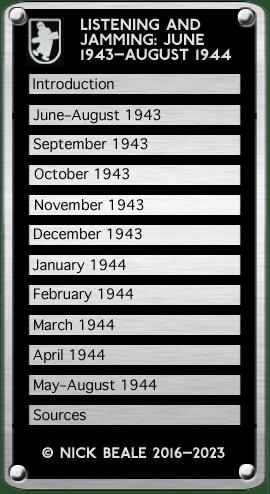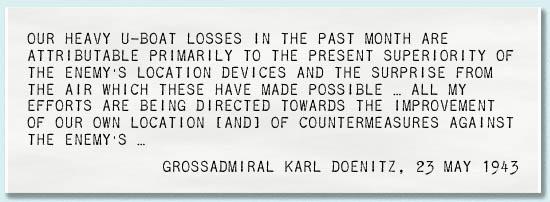 |
||
|
Airborne countermeasures against Allied ASV radars in the Mediterranean theatre seem largely to have ceased in November 1942 as ground was lost in Africa and Axis supply convoys were no longer routed to Libyan ports. Efforts appear to have been revived by the dramatic reverses suffered by the U-boat fleet the following Spring although concerns had been mounting for some weeks. On 2 February 1943 the Kriegsmarine war diary had noted with apparent satisfaction, “The bad experiences which hostile anti-submarine aircraft have had in recent months against U-boats fitted with FuMB [radar-warning receivers] …” Barely three weeks later the head of the Marine Waffenamt (Office of Naval Ordnance) was reporting that: A radio device in a captured English aircraft has been found which operates on a wavelength of 5.7 cm. Since our own gadgets don’t pick up the waveband below 20 cm, very considerable dangers arise from this uncontrollable and unjammed activity by the enemy in the ultra-short wave, especially in the area of the possibilities for radar … [Großadmiral Dönitz] refers to two recent U-boat losses in Biscay, possibly attributable to radar in the waveband we are not monitoring and orders defensive measures in this area to be pushed forward with energy and expedition. In March, 10 U-boats were being fitted with fixed radar-monitoring antennae and the Signals Branch was reporting on the addition of optical indicators to warning receivers so that “inaudible frequencies” showed up. On top of that, Fliegerführer Atlantik was warning of “an appreciable deterioration in the air situation over the Biscay area” because V./KG 40’s Ju 88 C-6 was proving inferior to the latest Allied types, leaving him unable adequately to protect U-boats on passage. Advice went out to all U-boats during the evening of 22 May that “the danger of being taken by surprise by locating [i.e. radar-equipped] aircraft is very great, especially at night”. During the summer a new unit appeared under Flifü Atlantik. For some time, Allied intelligence analysts, reliant on sporadic and limited information, were as unsure of its name as they were of its purpose. Its activities generally entailed an He 111 taking off from Bordeaux-Mérignac (or latterly Nantes) during the hours of darkness and spending about eight hours over Biscay before returning to base next morning. Deciphered messages and Y-Service monitoring occasionally revealed intended operations, largely through routine safety warnings to the Kriegsmarine and Flak that friendly aircraft would be crossing the coast at particular times. They also logged contacts with ground stations regarding intended landings but nothing seems to have been transmitted about any results achieved. That August, prisoners from KG 40 would dsiclose more details.
continued on next page …
|
||||



